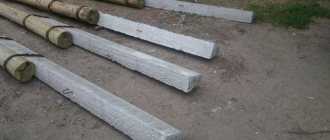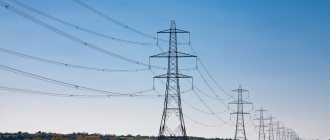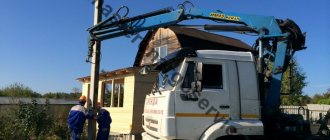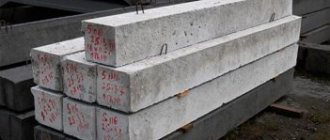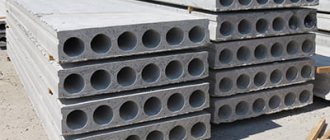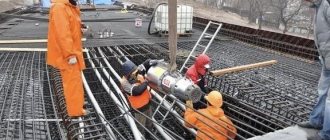Characteristics of reinforced concrete transmission line racks
⇒Reinforced concrete pillars are made of different brands and are designated in this way, for example, concrete post SV 95-2, where 95 is the length of the post in decimeters, and 2 is the conditional load-bearing capacity.
According to GOST 23009-78, racks are manufactured in the following standard sizes:
- L – 9.5 meters (NE 95)
- L – 10.5 meters (CB 105)
- L – 11 meters (NE 110)
- L – 16.4 meters (NE 164)
They also differ in the method of reinforcement, on which the load-bearing capacity depends.
Power transmission line support racks SV 95
Reinforced concrete poles SV 95 are widely used for laying and installing networks with a voltage of 0.4 kV and for laying communication lines. They are mainly used for connecting summer residents to electrical networks when installing an additional power pole. For their manufacture, heavy concrete (class B30) is used, which complies with GOST 26633-91 standards. As a filler for this concrete, manufacturers use granite crushed stone with a strength index of at least M 1200 - M 1400, frost resistance F 300.
SV 95 racks can be operated at temperatures reaching -55 degrees Celsius. They are successfully operated in areas of category IV and can be installed where seismicity does not exceed 7 points on the Richter scale. Reinforced concrete power transmission line supports SV 95.2 and SV 95.3 are equipped with embedded products necessary to fasten structures and connect the necessary grounding elements. These racks taper towards the top and their length is 9.5 meters. The cross-section of the supports is rectangular and equal to: height at the base – 240 mm, at the top – 165 mm, width at the base and top is the same – 150 mm. The weight of the rack is 750 kg.
The SV-95 reinforced concrete pole at the manufacturing enterprise is supplied with embedded iron products intended for connecting structures and grounding parts.
The distance at which power lines are installed to the fence
In the matter of building a house and equipping its territory, many issues are important. This includes the distance from the power line to the fence, which everyone who has started building a fence for their private plot should know about. The safety of those who come to the territory on vacation or permanently reside on the territory depends on the correct calculation of the distance from power lines to the fence of a private house.
Diagram with dimensions of the location of the fence from the power line
Important points
A person uses electricity all the time, be it at home, in the country or in the office. But few people delve into the fact that power lines not only supply a useful resource, but can also be harmful due to magnetic fields, and in case of failures they become unsafe for humans. It is imperative to adhere to the established rules, which indicate the required distance from the support to the fence of a residential private house for the following reasons:
- To preserve the health of building occupants.
- In order not to suffer from the effects of airborne electromagnetic fields that have a detrimental effect on the human brain.
- In the security zone of power lines, where the voltage level is especially dangerous for humans, the issue of locating residential buildings is especially acute. If the level of danger is off the charts, the area is fenced off with an industrial fence and a ban on construction in this area is put in place.
Power line protection zone diagram
Therefore, SNiP establishes distances from power lines to the fence of a house not just so that people do not receive fines for violations, but for the safety of the population of cities and villages.
The sanitary standards related to power lines clearly and in detail describe at what distance from power lines fences can be installed. This distance depends on the voltage level in the wires. In places of special tension, which are specially equipped, there are sanitary zones, near which it is prohibited to place fences and build residential buildings.
Safe distance from power lines
A requirement is established for the distance from the fence at the dacha to the place where the power line support is located, based on the voltage class.
Some owners of private plots turn to city or rural self-government bodies in order to obtain information about the voltage class in power lines located near their summer cottage.
Of course, not knowing how to determine the voltage level in the wires, it is better to do just that, so as not to unwittingly become a violator of SNiP requirements and endanger the residents of a private plot.
However, there is a method by which you can independently determine the voltage level in power poles.
Diagram of voltages in power lines of various types
If the voltage is very small, then it can be determined by counting the insulators.
How to increase your security level
Even having fully complied with all the norms and requirements regarding the distance of the fence from the poles through which electricity passes, houses built near power lines are still at risk in unforeseen situations and must protect their private sectors. This can be done in the following ways:
- Select a roof with grounding for the construction of the house,
- Install reinforcing mesh inside the wall structure. This solution will help reduce the risk of penetration of harmful electromagnetic waves into the living space,
- To increase the level of safety for home residents, fruit trees should be planted at a horizontal distance of at least 2 meters from power lines.
Minimum permissible distances from trees to power lines
Recommendations
The requirements in SNiP are prescribed primarily for the safety of people, and not to fulfill the wishes of self-government bodies. Therefore, you should not neglect safety rules, especially when it comes to electrical voltage.
It is worth paying maximum attention to calculations at what distance it is safe to install a fence from power lines. Only a properly installed fence will provide comfort and limit the residents of a private plot from troubles and danger.
Installation of concrete supports
Calculation of supports is carried out by SNiP 2.02.01-83 and “Guide to the design of power lines and power line foundations...”. The calculation is based on deformation and bearing capacity.
To secure an intermediate support of type P10-3(4), you need to drill a cylindrical pit with a diameter of 35-40 cm, to a depth of 2000-25000 mm. An installation bolt is not needed for such a support.
Anchor corner and anchor branch supports are usually mounted with installation crossbars. Please note that the crossbars can be placed on the lower edge of the support and strut, buried in the ground and/or on the upper edge of the support, along the top of the pit. The crossbars provide additional stability to the support. The depth of installation of the support depends on the freezing of the soil. Usually 2000-2500 mm.
Regulatory Requirements
Please note: the adopted document canceled the validity of the older PUE. The changes affect, among other things, the chapter “Electricity sewerage” that is relevant to us.
Let's pay attention to the most important points of the document in our case
General requirements for lines with voltage up to 1 kV
- When hanging any unprotected wires on supports, the distance from them to windows or balconies at maximum deviation should not be less than 1.5 meters.
- Above the carriageway, the wires are hung at a height of at least 6 meters, above the impassable part - at least 3.5 m.
The height of the wires above the roadway and pedestrian paths.
- The distance between the wires when spanning up to six meters must be at least 10 cm, when spanning over 6 meters - at least 15 cm.
- Entry into the building is carried out at a height of at least 2.75 m; in this case, an insulating pipe is used for entry, the shape of which prevents water from entering the house.
- The structures on which the conductors are installed are made of fireproof materials and must have a fire resistance rating of at least a quarter of an hour.
Comment: it would seem that this point puts an end to wooden pillars. But... no, a loophole remains: wood impregnated with a protective composition does not support combustion.
- The minimum distance from bare wires to a pipeline for any purpose is 1 meter. If the wire is insulated, the distance is not standardized.
- Insulators must be fireproof. Traditionally, porcelain and glass are used for this purpose.
The photo shows porcelain insulators.
Requirements for overhead lines with voltage up to 1 kV
The supports should not impede passage and passage, or block entrances to courtyards.
Where there is a possibility of being run over by a car, the support is protected from collision with it by a bumper or any other method.
The pole should be marked at a height of 2.5 - 3 meters. It indicates the serial number of the support, the width of the security zone and the telephone number of the line owner.
All metal structures are protected from corrosion. The method of protecting the PUE is not specified; Traditionally, painting is used for this.
The minimum wire cross-section for an overhead line is limited by its mechanical strength and is determined by the material.
| Wire type | Minimum cross-section, mm2 |
| Aluminum | 16 |
| Steel-aluminum | 10 |
| Bimetallic | 10 |
| Steel stranded | 25 |
It’s curious: for a single-wire steel wire, it’s not the cross-sectional area that is limited, but the diameter. It should not be less than 4 mm.
The branch from the nearest support is carried out only and exclusively with an insulated wire. The maximum branch length is 25 meters.
The input is made with an insulated wire.
To connect the wires, connecting clamps or welding are used. Single-wire wires can be connected by twisting followed by soldering; but you can’t butt weld them. In this case, a wire that differs in material or cross-section of the current-carrying core is connected only with clamps.
The minimum cross-section of the entrance to the house is also limited by the document; and in this case the cross-section is determined by the type of wire:
| The wire | Minimum section or diameter | |
| Span up to 10 meters | Span 10-25 meters | |
| Copper self-supporting | 4 mm2 | 6 mm2 |
| Steel or bimetallic | 3 mm | 4 mm |
| Aluminum | 16 mm2 | 16 mm2 |
Supports
What should the actual pillar be like?
For low-voltage lines, reinforced concrete, metal, solid wood and wooden poles with a concrete base can be used. All types of wood, except larch, must be impregnated with an antiseptic; Larch wood itself is extremely resistant to rotting.
Wood is the most affordable material for a pole.
When using a wooden support, its minimum diameter (at the top end) should be:
- For the main power supply line - 14 cm;
- For a branch to a house (in particular, for a pole installed on a site) - 12 cm.
Regarding the deepening of supports, the document is somewhat vague - “depending on local conditions.”
What should be the minimum distance from the pole to surrounding objects and communications?
| An object | Distance, meters |
| Water pipelines, heating mains, sewerage | 1 |
| Fire hydrants, water pumps, water wells | 2 |
| Power cables (for example, a wire from a well pump) without additional protection (insulating pipe) | 1 |
| Power cables in conduit | 0,5 |
How to install correctly
After you decide on the choice of material, you need to calculate at what distance the poles will be from each other, and how many of them you will need in general to provide electricity to the entire area.
For this, there are standards established by electrical engineers. This takes into account the length of the pole and what wire will be used.
From the calculations you can find out how many meters there should be between the pillars. After which, you can begin drilling wells for further installation of pillars in them.
Also, if you need to deviate from the course of the line and, for example, “power” a barn, it is not necessary to install all the same pillars on the way to it. There are small intermediate racks for these purposes. They do not require a support post due to their small size. They can also be used for street lighting in a summer cottage.
Please note: you should not connect the site to the main line yourself, even if you know how to handle electricity! If you connect on your own, you will definitely be fined! Therefore, it is better to obey the demands of the authorities. And then your home will be light and cozy
How to place a support under power lines manually, see the following video:
If you have purchased a country house or are about to start building it, then sooner or later you will be faced with the question of connecting to the electrical network. Often, in connection with this, there is a need to install a power line support near the site. In general, the installation of poles should be carried out by government organizations and this work should be done for free, but in practice everything is not so smooth, and you will have to wait several years. Special organizations can solve this problem for some money.
When hiring specialists, there is no need to delve into the intricacies of the work, but you still need to know certain information. Electricity poles come in three types:
- wooden supports are the cheapest, but not particularly durable;
- reinforced concrete pillars are the most common in use;
- iron power line supports are the most expensive.
Which pole to choose depends on the climatic conditions and the power of the energy consumer.
The approximate cost of installing electricity poles is as follows:
- installation of one pole - 30-35 thousand rubles;
- five pillars - 100 - 120 thousand rubles;
- ten supports – 170 thousand and above.
Let's figure out how these amounts are obtained. Firstly, the cost of installation also includes the price of the pole itself, and secondly, all installation features are taken into account.
Work on the site, provided for by the technical specifications
It is advisable to trust the implementation of the power supply plan on a site for individual housing construction, as well as the scheme itself, to specialists if you want electrical communications to be as efficient and reliable as possible. But even in this case, it is better for the owner to understand the features of the electrical infrastructure in order to control the work and have confidence that everything is done correctly.
The main element of the system on the site is a pipe stand receiving device with a meter that will take into account electricity consumption. House construction, outbuildings and electrical appliances on the site are powered from it
It is extremely important to wisely select materials for the implementation of the scheme. Electricity is supplied through a cable; the air installation method is predominantly used
In this case, SIP 4 with a cross section of 16 mm3 is most often used. Its insulation is made of polyethylene, which is not destroyed by ultraviolet radiation, and its service life reaches a quarter of a century. Depending on what circuit is implemented on the site (single-phase or three-phase), a cable with either two or four cores is used.
In recent years, underground cable laying has been gaining popularity. In this case, it is better to choose a VVG copper cable with a cross-section of 10 mm3, or an aluminum AVBbShv cable with a cross-section of 16 mm3. If you use armored grades, they can be laid directly under the ground; conventional grades are pulled through a HDPE pipe. Entry into housing construction with underground installation is carried out in the same way as with the air method.
Pipe stand, its functions and installation methods
A pipe stand is a piece of pipe intended for fastening cables; wires are introduced into the area through it. An electrical panel is also installed on it. According to technical standards, the distance from the surface of the earth to the entry of electrical wires into the house must be at least 2.75 meters. Such parameters are necessary in order to avoid accidental contact. If the dimensions of the buildings cannot meet such requirements, a pipe stand is installed.
It is made of steel pipes, the diameter of which should be: when entering 2 wires - 20 mm, when entering 4 wires - 32 mm. No moisture should get into the pipe; therefore, its top should be bent 180 degrees. To avoid corrosion, it is advisable to cover the pipe stand with paint or bitumen. The gander can enter the building either through the roof or through the wall. If there are no buildings on the site yet, the pipe stand can be installed on the ground, subject to the technical conditions applicable in this case.
What components are required in an electrical panel?
Current technical standards require the presence of the following devices in the electrical panel: input packet, meter and RCD. All devices must comply with the parameters of the circuit features.
An RCD is a mandatory component, it is the safety of the house and household members, even if it operates only once during the period of operation, this will prevent serious problems associated with fires and electric shocks. The circuit breaker provides protection against short circuits and line overloads.
Padlock on the counter is a required attribute
Fastening the SIP cable to the pipe stand
To protect the lock mechanisms and allow easy opening, use wd40
A meter is required in the system to record electricity consumption; monthly payments are calculated based on its readings. These metering devices have many modifications, which are classified according to many criteria: principle of operation, accuracy class, connection features, number of measuring elements and other factors. Multi-tariff meters are in high demand because they allow significant savings on electricity bills.
Metering devices with a day/night tariff are equipped with a set of counting mechanisms, each of which operates at a strictly defined time of day. This is how accounting is formed using different algorithms. In the vast majority of cases, the multi-tariff accounting system generates significant savings for the family budget. Without a metering device, the power supply circuit cannot be put into operation.
The meters are reconciled and sealed by employees of the network company during inspection, before the actual connection of electricity. After which, acts on completion of work and connection of a new subscriber are drawn up.
Do not forget to install sockets in the panel in order to connect construction tools during the construction of the house
One of the seals on the shield
Ground wire is required
Estimate for pipe stand and prices for materials
Why is removal from power lines necessary?
The distance from the fence to the power line, required by law, is not just a way to ensure the maintenance and operation of high-voltage lines. The Moscow government plans to transfer such networks to underground ones, because constant exposure to an electromagnetic field is extremely harmful for people living in such conditions.
This is not only a danger of oncological processes, but also the possibility of developing endocrine, immune and nervous pathologies. Even in a village where the number of people per square meter is much smaller. km, the state requires ensuring the health safety of its citizens by establishing sanitary and protective standards.
They regulate not only the security areas in the electromagnetic field zone, but also the distances from the wires to the roadway (at least 6 m from the pedestrian path (starting from 3.5 m) and the height of the branch near the house (starting from 2 m 75 cm)) . Scientific studies have established the influence of e/m fields on reproductive function in men and the possibility of causing miscarriages in women.
If rural or urban areas are taken into account, then the distance standards are still aimed at:
preventing fire in the fence of a residential building or utility room in the event of a probable accident that no one can foresee; take the maximum possible precautions regarding the health of people living in an area located in close proximity to power lines (no matter what kind of area it is, even if it is a country house where people do not live permanently); to prevent possible consequences from weather conditions that caused a fall, destruction of the structure or release of accumulated charge into the atmosphere.
In order to increase their security, many owners build a roof with grounding, lay reinforcement structures in the walls and specially plant fruit trees at a safe distance.
However, all this is not enough if the power line is located at an insufficient distance from various buildings. And the necessary standards can be easily determined by the appearance of the structures or by making inquiries with the relevant authorities. But in any case, the minimum distance is at least 10 m.


